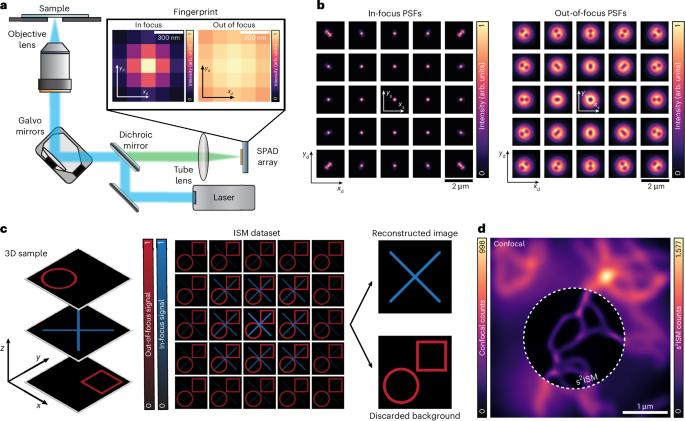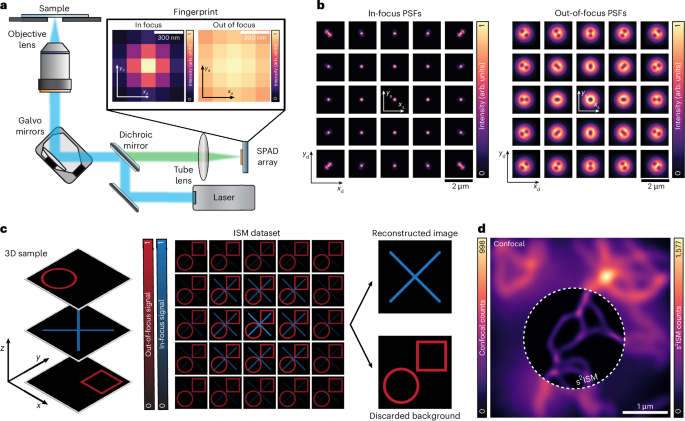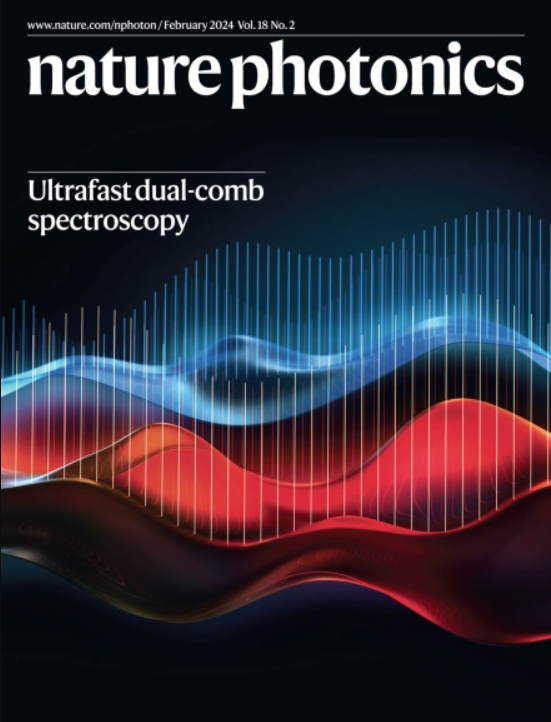激光扫描显微镜超分辨光学切片的结构检测
IF 32.9
1区 物理与天体物理
Q1 OPTICS
引用次数: 0
摘要
快速探测器阵列能够有效地实现图像扫描显微镜,克服了共聚焦显微镜的空间分辨率和信噪比之间的权衡。然而,目前的图像扫描显微镜方法不能提供光学切片,并且除非检测器尺寸有限,否则无法处理厚样品,从而在光学切片和信噪比之间引入了新的权衡。在这里,我们提出了一种克服这种限制的方法。在单平面采集的基础上,利用数字和光学超分辨率、高信噪比和增强的光学切片重建图像。在观察到探测器阵列成像固有嵌入轴向信息的基础上,我们设计了一种简单的重建算法,该算法可以反转图像扫描显微镜图像形成的物理模型。我们提出了一个全面的理论框架,并通过使用配备单光子雪崩二极管阵列探测器的定制设置捕获的生物样品图像验证了我们的方法。我们通过在线性和非线性条件下激发荧光发射来证明我们方法的可行性。此外,我们推广了荧光寿命成像算法,充分利用了单光子雪崩二极管阵列探测器的单光子定时能力。我们的方法优于传统的重建技术,可以扩展到任何激光扫描显微镜技术。本文章由计算机程序翻译,如有差异,请以英文原文为准。


Structured detection for simultaneous super-resolution and optical sectioning in laser scanning microscopy
Fast detector arrays enable an effective implementation of image scanning microscopy, which overcomes the trade-off between spatial resolution and signal-to-noise ratio of confocal microscopy. However, current image scanning microscopy approaches do not provide optical sectioning and fail with thick samples unless the detector size is limited, thereby introducing a new trade-off between optical sectioning and signal-to-noise ratio. Here we propose a method that overcomes such a limitation. From single-plane acquisition, we reconstruct an image with digital and optical super-resolution, high signal-to-noise ratio and enhanced optical sectioning. On the basis of the observation that imaging with a detector array inherently embeds axial information, we designed a straightforward reconstruction algorithm that inverts the physical model of image scanning microscopy image formation. We present a comprehensive theoretical framework and validate our method with images of biological samples captured using a custom setup equipped with a single-photon avalanche diode array detector. We demonstrate the feasibility of our approach by exciting fluorescence emission in both linear and nonlinear regimes. Moreover, we generalize the algorithm for fluorescence lifetime imaging, fully exploiting the single-photon timing ability of the single-photon avalanche diode array detector. Our method outperforms conventional reconstruction techniques and can be extended to any laser scanning microscopy technique. A reconstruction method for image scanning microscopy exploits all the information encoded in the four-dimensional image scanning microscopy dataset to achieve optical sectioning and maintain super-resolution and high-signal-to-noise-ratio imaging.
求助全文
通过发布文献求助,成功后即可免费获取论文全文。
去求助
来源期刊

Nature Photonics
物理-光学
CiteScore
54.20
自引率
1.70%
发文量
158
审稿时长
12 months
期刊介绍:
Nature Photonics is a monthly journal dedicated to the scientific study and application of light, known as Photonics. It publishes top-quality, peer-reviewed research across all areas of light generation, manipulation, and detection.
The journal encompasses research into the fundamental properties of light and its interactions with matter, as well as the latest developments in optoelectronic devices and emerging photonics applications. Topics covered include lasers, LEDs, imaging, detectors, optoelectronic devices, quantum optics, biophotonics, optical data storage, spectroscopy, fiber optics, solar energy, displays, terahertz technology, nonlinear optics, plasmonics, nanophotonics, and X-rays.
In addition to research papers and review articles summarizing scientific findings in optoelectronics, Nature Photonics also features News and Views pieces and research highlights. It uniquely includes articles on the business aspects of the industry, such as technology commercialization and market analysis, offering a comprehensive perspective on the field.
 求助内容:
求助内容: 应助结果提醒方式:
应助结果提醒方式:


